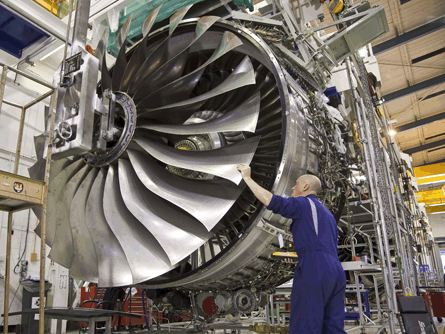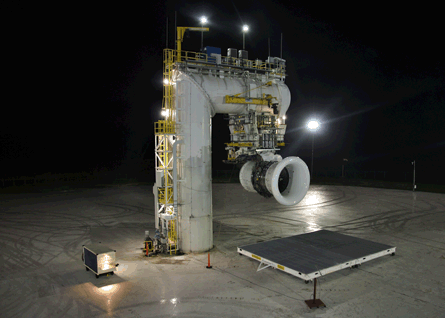Thanks to its status as sole engine supplier for the Airbus A350 XWB, Rolls-Royce is gearing up to build Trent XWB turbofans at the rate of almost one per working day by 2018.
The engine - the largest yet produced by the UK manufacturer, with a 3m (118in) fan diameter - is being prepared for its first flight aboard Airbus's A380 testbed (MSN001) in the third quarter of 2011. A pair of Trent XWBs will subsequently power the A350 on its maiden flight scheduled for late next year.
Although the Trent XWB's fan is only 51mm larger in diameter than that of the A380's Trent 900, Trent XWB chief engineer Chris Young points out that the smaller fan hub of the new engine means that each blade is 76mm longer and has 50% more surface area. "This is the biggest blade we've done by quite some amount," says Trent XWB programme director Chris Cholerton.
 |
|---|
© Rolls RoyceEach blade is 76mm longer than those on the A380's Trent 900 |
Four development powerplants have already been run on the ground and double that number are due to be on test by July. Early results from the instrumented engines are encouraging, says Young.
"We are beating expectations. Most of that benefit is in the compressors, which are performing very, very well. The compressors are demonstrating very high levels of surge margin - more than we need.
"We're looking at whether we can trade some of the surge margin back into higher pressure ratios and better specific fuel consumption," he adds.
The performance improvements could be introduced into flight-compliant engines ready for testing by the end of this year and yield an SFC reduction of around 0.25%, says Young.
In addition to the eight bench development engines, one engine will be installed on the A380 testbed and another held as a spare for the flight-test phase. A total of 13 flight compliant engines will be supplied for the five A350 flight-test aircraft (including three spares). One more engine will be used solely for maturing the assembly process.
Certification of the Trent XWB will be achieved "when we need to" ahead of the first flight of the A350, says Cholerton.
"We've got three engines dedicated to maturity, in an attempt to have a higher level of testing prior to entry into service than we've had on previous Trents," he says. "The focus here is maturity at entry into service. Certification is just a step on the way."
As part of the Trent XWB development effort, R-R has invested in what is thought to be the most powerful, real-time digital X-ray system in western Europe, which has enabled it to measure turbine blade tip movement relative to seal positions and identify oppportunities to boost efficiency.
Previously, using film-based X-ray systems "we used to get four images in a day and take a long time to analyse them", says Young. "Now, we get 4,000 images in the same time, which we can run into a film and instantly be able to look at the data.
"We originally started with four stages of variable vanes on the IP compressor. We're actually deleting one of those stages because we've had such good surge margin results. We were able to reduce the weight, cost and complexity of the IP compressor," says Young.
 |
|---|
© Rolls Royce |
He adds: "That puts us well on track to meet - if not exceed - our performance guarantees to Airbus from entry into service."
Bird-ingestion tests are pending, with trials involving "medium" birds taking place in June and "large flocking" birds the following month. Another Trent XWB started endurance testing this month, and a further example will be used for cyclic tests from July.
Cholerton says the uncontained failure of a Trent 900 powering a Qantas A380 last November did not lead to design changes on the Trent XWB.
"We have a very different design style in the area of the failure and we're planning no direct changes in that area as a result of QF32," he says.
A major focus for the Trent XWB programme is achieving production readiness, given the required fast ramp-up of the build rate.
"Where we have novel manufacturing capabilities we have structured risk reduction," says Cholerton. "About 43 workstreams are manufacturing details which are different to those that we have previously executed reliably at rate [for previous Trents], so we take each of those through a structured risk-reduction process."
For example, one component entering series production for the first time is the Trent XWB's three-stage HP compressor blisk.
A dedicated pre-production facility is being set up to assemble flight-compliant engines and hone the manufacturing process.
"The objective of that facility is to take the lessons from development build - which has some out-of-sequence work and a lot of instrumentation and suchlike - and standardise the assembly method with the objective of minimising the build time," says Cholerton. "That will be in place later this year and the first parts arrive for flight-compliant engines by the end of this year," he adds.
Full series production is due to get under way in late 2012 ahead of the A350 production ramp up in 2013. Some of the early production engines may also be assembled on the pre-production line.
"It depends on the stability of the process," says Cholerton. "We'll exit pre-production when we feel we have a totally stable process, but nominally this will be the back end of 2012," says Cholerton.
Although the Trent XWB's initial thrust rating for the A350-900 will be 84,000lb (374kN), the engine basic engine has already been run at 100,000lb-thrust in testing, well above the level required for the stretched -1000 variant of the airframe.
"We do insert high-temperature technology into the engine [for the -1000]," says Cholerton. "A couple of the demonstrators which are helping to mature that technology are the Trent 1000-based Environmentally Friendly Engine demonstrator and the E3E two-shaft demonstrator, which gives us important information on the tip clearance control and the shroudless blade system that we will use on the variant of the engine for the -1000."
The configuration of the growth version of the engine is due to be finalised in the first half of 2012.
Bench testing of the baseline Trent XWB has underpinned work on the growth variant, says Young.
Source: Flight Daily News























